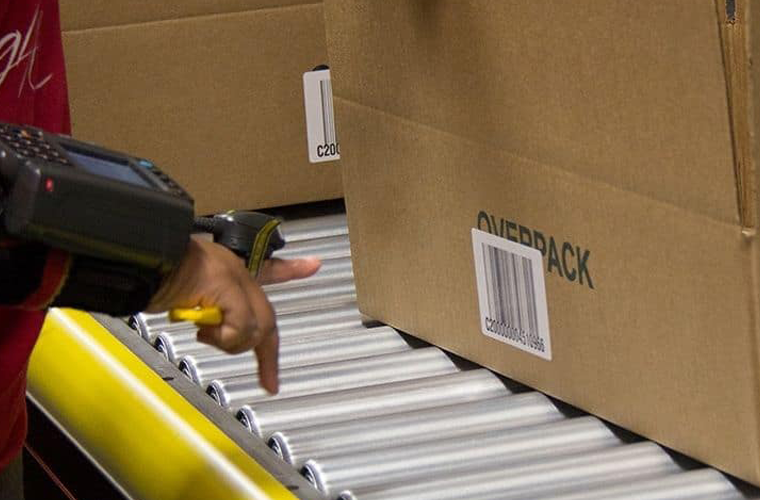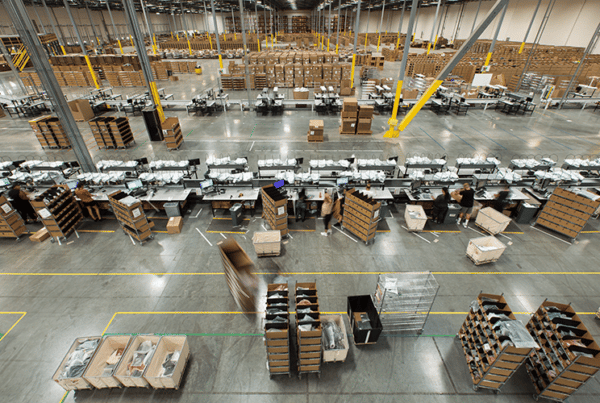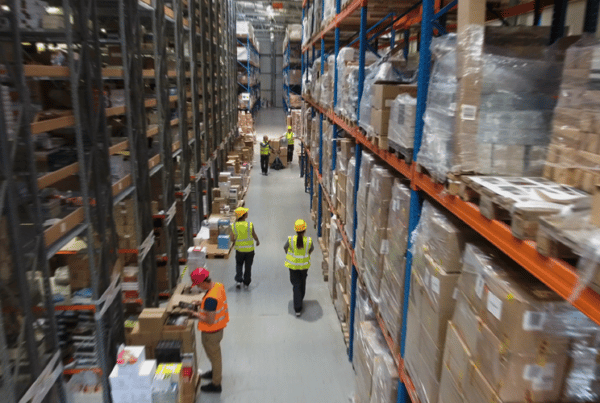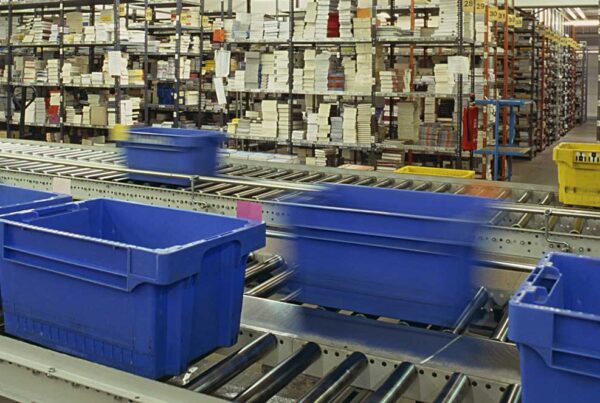Warehouse wearables are computers, scanners, and communication devices engineered to be small and ergonomic enough for operators to wear throughout their shift. They are similar to mobile devices but with the added benefit of being hands-free and eyes-up. They improve the user’s experience in interfacing with a facility’s systems and processes, and increase material handling efficiency, accuracy, and safety.
Among the challenges of integrating wearable technology is the sheer number of options, including devices, operating systems, and brands. At PeakLogix, we have decades of experience helping companies integrate bleeding-edge technologies that increase efficiency and drive profitability. We are system-agnostic, dedicated to our collaborative approach, and work to find solutions that both solve today’s challenges and open avenues for growth.
The benefits of warehouse wearables
The exact benefits a company will realize by implementing wearables depends on many factors, including the industry, the materials they’re moving, their current processes, their plans for the future, and the quality of the integration.
As with most technologies, the ROI for wearables is easier to realize in higher throughput facilities. However, advances [and increased use] in technologies and their infrastructure – such as high-speed internet and facility-wide Wi-Fi – are lowering costs and increasing value for many facilities.
How do warehouse wearables increase efficiency?
Warehouse wearables increase material handling efficiency in a number of ways, depending on the exact technology. In general, they decrease touches and touchpoints, act as a seamless user interface for logistics applications, minimize the time operators spend on non-value adding tasks, and simplify or completely automate repetitive tasks.
For example, operators wearing a voice-picking headset can use a voice command to trigger an AMR workflow, as opposed to stopping to interact with a computer terminal or handheld device. Or an operator wearing a wrist scanner could trigger the same workflow while passing a barcode. Or an operator with a heads-up display might be given precise directions to a pick face.
How do warehouse wearables decrease touchpoints?
Warehouse wearables decrease touchpoints – or the number of steps a task requires – by allowing heads-up, hands-free operations. In conventional paper picking, an operator might have to interact with a clipboard multiple times – sometimes for the same pick – to locate an item and verify it was pulled from inventory. To lift an item, they might first have to locate a handheld scanner, scan the item, set the scanner (in a place they can relocate it easily!), and then lift the item. Often, to cut corners, operators will lift items while still carrying the scanner.
With a heads-up display or voice-directed picking, the operator could follow the directions without ever taking their eyes from their path. They can better focus on the task at hand and their environment, without shifting their attention between their job and a computer screen, tablet, or clipboard.
Using wearable wrist scanners means not having to interact with – and potentially misplace – handheld scanners. They can also keep both hands free so that operators can lift boxes or sort items more quickly, while allowing for better range of motion.
The more focused operators can stay on their tasks, without being distracted by checking and rechecking clipboards or finding a misplaced handheld device, the more accurate they will be.
How do warehouse wearables increase safety?
One aspect of warehouse wearables that companies have benefited from since 2020 has been the improved ability to contact trace. Finding what zones an operator using a wearable device entered was as simple as reviewing a work log. Finding what two operators came into contact during any given shift was as simple as running a program.
More than that, warehouse wearables can detect and monitor key operator vital signs. This data can be used to find places in a workflow that might benefit from automation, and also to ensure an employee’s well-being. In facilities with hazardous conditions, such as dangerous volatiles, the ability to find an employee quickly can be a matter of life or death.
GPS and beacon technologies can also be used to keep operators out of dangerous areas, either by alerting them or a facility manager, or by automatically stopping processes before an operator gets too close.
How do warehouse wearables increase process transparency?
Warehouse wearables, combined with computer infrastructure capable of processing big data, increase process transparency by being physically present with operators at nearly all times. Tracking a device’s movements throughout a facility, and analyzing large amounts of data over time, operators and managers can find ways to improve a facility’s layout, storage solutions, processes, and even motive power.
The types of warehouse wearables
Warehouse wearables come in a wide range of types, from scanners that can be worn on a finger to full-body exoskeletons to assist in heavy lifting. However, between those extremes we find commonly used, affordable wearables that benefit companies in many industries.
Smart glasses and AR headsets. Smart glasses and augmented reality (AR) headsets are often combined with other technologies to enable multi-modal processes. In a warehouse environment, for example, an operator might use both a wrist scanner and heads-up display to maximize their picking efficiency.
Voice control headsets. Voice control headsets create a more seamless interaction between a facility’s system and the user. Users can receive and verify picking orders, locations, and counts, and also give commands to the system. For example, after receiving instructions to pick an item, an operator might signal the system to send an AMR with an empty pallet to a certain location.
Wrist scanners. Because of the variety of information that can be encoded in a barcode, wrist scanners are a versatile technology. They allow operators to verify information such as items, locations, and counts. And they can also signal a warehouse management system to begin a process, such as sending an automated tugger on its route.
Fitness bands and smartwatches. Once the purview of the gym and track, fitness bands and smartwatches are increasingly used to help facilities measure the efficiency of their layout by tracking steps. Smartwatches enable apps that can aid inventory management and perform many of the functions of wrist scanners.
The challenges of integrating warehouse wearables
Aside from the generic issues common to all investments – such as looking for ROI and defining use cases and scales – warehouse wearables have some particular complexities that have to be addressed.
Internet and Wi-Fi. To enable wearable technologies, a facility needs reliable internet and stable Wi-Fi throughout a facility.
User acceptance. Any technology is only as useful as it is used and, if operators don’t understand the value of a technology to their role, they are likely to use it only sporadically, or forgo it altogether.
Learning curve. While every new technology comes with a learning curve, most wearables are both intuitive and straightforward. Nevertheless, a poorly introduced technology that isn’t well received by its users will often seem to have an insurmountable learning curve.
Implementation. While many of these technologies are easy to use, they aren’t plug-and-play. They need to be integrated with a facility’s existing processes in a way that minimizes any negative effects while the implementation is happening and maximizes productivity when the implementation is complete.
A successful implementation will also consider security and privacy of its data and users
As with any software, these systems and their users can be the targets of malware, phishing attacks, and network overloads. Depending on the sensitivity of the data being stored, keeping this information secure can be paramount.
Normal security measures – updating passwords periodically, keeping antivirus software up to date, and ensuring employees are informed – are generally adequate. But if this is the beginning of your facility’s journey into automation, you may need to update your security protocols. And even if this isn’t your first step into automation, updating your protocols periodically is a good best practice.
Related to security of proprietary information is the privacy of the technology’s users. Data collection should be limited to employer-owned equipment and legitimate business needs. Have a GPS tracking policy on your books and limit your use to that policy. Depending on your state and local laws, tracking an employee unnecessarily or after hours may be illegal, and is certainly neither a responsible nor respectful use of the technology.
An experienced systems integrator can help you navigate these challenges, maximize your ROI, and successfully integrate these technologies into your existing processes.





